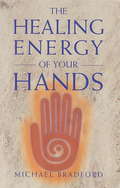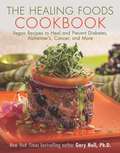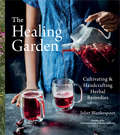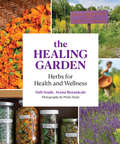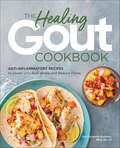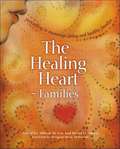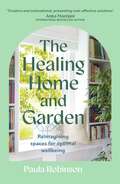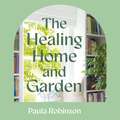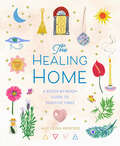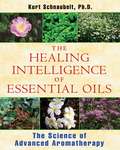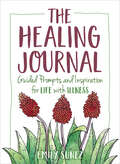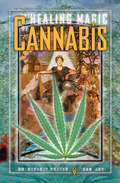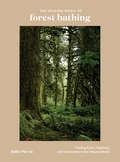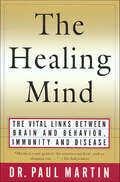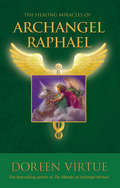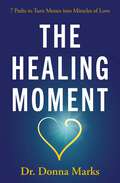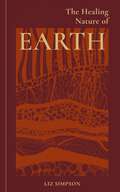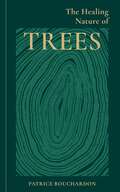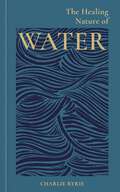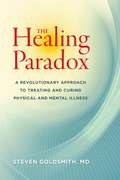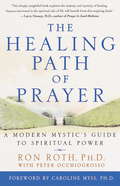- Table View
- List View
The Healing Energy of Your Hands
by Michael BradfordTHE HEALING ENERGY OF YOUR HANDS demystifies the art of healing. Beginning with a basic explanation of the nature of healing energy, illness, and the role of the mind in the healing process, Bradford offers techniques so simple that anyone, even a child, can work with healing energy. The author'¬?s intention is that anyone using his book can awaken his or her natural healing talents quickly and easily.Topics include sensing energy, clearing energy blockages, eliminating negative self-talk, using affirmations, balancing the chakras, cleansing the auric field, relieving pain, and creating forgiveness.
The Healing Foods Cookbook: Vegan Recipes to Heal and Prevent Diabetes, Alzheimer’s, Cancer, and More
by Gary NullAmerica’s love affair with pro-inflammatory sugars, fats, animal proteins, preservatives, additives, and high-temperature cooking has given rise to devastating health consequences. As rates of chronic degenerative disease surge around the country, it’s more important than ever to dispel the myths surrounding a plant-based diet and get people excited about choosing foods that truly can be both nutritious and gourmet. Gary Null has witnessed people make remarkable improvements in their health by eating a plant-based, pure foods diet, including individuals going from diabetic to nondiabetic and reversing the symptoms of autoimmune disease. Here are recipes and specific nutrient supplementation protocols for some of the most important health issues facing Americans today: diabetes, cognitive diseases, obesity, pain, cancer, allergies, and aging. Recipes include: Fettuccine asparagus Alfredo Fusilli with eggplant, broccoli rabe, and garlic Grilled tomatoes with tarragon Sesame amaranth polenta Spaghetti and shiitake saffron tomato sauce Thai macadamia noodles Skyhorse Publishing, along with our Good Books and Arcade imprints, is proud to publish a broad range of cookbooks, including books on juicing, grilling, baking, frying, home brewing and winemaking, slow cookers, and cast iron cooking. We’ve been successful with books on gluten-free cooking, vegetarian and vegan cooking, paleo, raw foods, and more. Our list includes French cooking, Swedish cooking, Austrian and German cooking, Cajun cooking, as well as books on jerky, canning and preserving, peanut butter, meatballs, oil and vinegar, bone broth, and more. While not every title we publish becomes a New York Times bestseller or a national bestseller, we are committed to books on subjects that are sometimes overlooked and to authors whose work might not otherwise find a home.
The Healing Garden: Cultivating and Handcrafting Herbal Remedies
by Juliet BlankespoorA comprehensive and lushly photographed guide to growing and using healing plants, including recipes, from the founder of the Chestnut School of Herbal MedicineThis is the ultimate reference for anyone looking to bring the beauty and therapeutic properties of plants into their garden, kitchen, and home apothecary. Both informative and accessible, it covers how to plan your garden (including container gardening for small spaces); essential information on seed propagation, soil quality, and holistic gardening practices; 30 detailed profiles of must-know plants (including growing information, medicinal properties, and how to use them); foundational principles of herbalism; step-by-step photographic tutorials for preparing botanical medicine and healing foods; and 70 recipes for teas, tinctures, oils, salves, syrups, and more. Packed with sumptuous photography, this book will appeal to home gardeners who want to branch out to culinary and medicinal herbs, home cooks and those interested in natural wellness, and novice and skillful herbalists alike.
The Healing Garden: Herbal Plants for Health and Wellness
by Deb SouleIn The Healing Garden, Deb Soule, founder of Avena Botanicals, offers an inspiring guide to herb gardening and crafting herbal remedies that promote wellness of spirit and body. Soule combines her passion for plants gardens, and healing with her extensive experience working with medicinal herbs, flowers, roots, and berries. Her practical advice addresses each aspect of fostering a garden filled with helpful, healing plants: biodynamic gardening practices; gathering plants and setting up a drying room; and creating herbal teas, decoctions, tinctures, syrups, tonics, vinegars, essences, and more. A chapter outlining eighteen medicinal herbs provides detailed information on their cultivation and healing properties. Molly Haley's colorful photography showcases Avena Botanicals' lush herb gardens in all seasons. The Healing Garden is grounded in respect for the interconnectedness of all living beings and is an eloquent plea for spiritual awareness and the wholeness of individuals, communities, and our planet.
The Healing Gout Cookbook: Anti-Inflammatory Recipes to Lower Uric Acid Levels and Reduce Flares
by Lisa Cicciarello AndrewsRelief from gout symptoms—through easy, delicious eatingGout attacks are painful, but research shows that adjusting your diet may help prevent and even heal symptoms of this difficult arthritic condition. The Healing Gout Cookbook is your guide to a nourishing, low-purine, anti-inflammatory diet full of fresh and flavorful foods. With these 85 simple, satisfying recipes, you can help control gout flare-ups—while enjoying what you eat every day.Find out how to reduce uric acid levels by decreasing your purine intake, and discover the benefits of anti-inflammatory and antioxidant-rich foods. The special recipes in this book are easy to follow and quick to prepare—so you can indulge in tasty meals while helping your body heal from gout symptoms.The Healing Gout Cookbook includes:85 flavorful recipes—Savor a variety of dishes like Black Bean Breakfast Scramble, Chili Garlic Green Beans, Balsamic Marinated Chicken, Blueberry Peach Cobbler, and more.Dietary friendly—Recipes are labeled for specific dietary restrictions, like kidney-friendly and diabetic-friendly, and include variation tips to make life easier.At-a-glance facts—Encourage or avoid the right foods with the help of a handy purine level chart, and stock your kitchen in a snap with a list of pantry essentials for a gout friendly diet.Spend more time doing the things you love without pain with The Healing Gout Cookbook.
The Healing Heart—Families: Storytelling to Encourage Caring and Healthy Families
by Allison M. Cox and David H. AlbertStories and narratives aimed at helping families work through an array of subjects like health, illness, grief, adoption, sexual identity, and school.The Healing Heart provides powerful examples of the use of stories and storytelling in encouraging resiliency, empathy, respect, and healing. These engaging books contain stories, and narratives about the use of the stories in activities with different populations (children, teens, those with disabilities, seniors, inmates, etc.) or which address specific social or community problems (addictions, poverty, violence, racism, environmental degradation, homelessness, abuse).The books are a collective effort containing the expertise of more than 60 storytellers and health professionals who illustrate the power of story in moving others to commitment and action, in building self-esteem and mutual respect.The Healing Heart ~ Families focuses on families, dealing specifically with healing through story, health promotion, disease prevention, early childhood intervention, children with medical problems, adopting families, schools, sexual identities, grief, and spiritual healing. The Healing Heart ~ Communities focuses on community-building, with sections on youth, violence prevention, poverty, domestic violence, substance abuse and addiction, racism, elders, culture, environmental protection, homelessness, and community development.Praise for The Healing Heart ~ Families“Both children and adults, sick or well, need the embrace of soulful storytelling. They need to witness and be witnessed, for it is in this state that healing occurs . . . . If newscasters were to read aloud each night to their listeners for 1,001 nights one of the stories from this treasury, we would all be healed and lose our fear, recapturing real security in our homeland.” —N. Michael Murphy, MD, author of The Wisdom of Dying“An extraordinary work . . . . Hit the bulls eye by providing both process and practice. Thought provoking and insightful theory is intertwined with appropriate stories for direct application. It makes clear that story can be a powerful catalyst for change, giving eloquent voice to what many of us have known for some time but have been unable to express. What a gift for those who work with families!” —Elizabeth Ellis, co-author of Inviting the Wolf In: Thinking about Difficult Stories
The Healing Home and Garden: Reimagining spaces for optimal wellbeing
by Paula RobinsonAre you tired of formulaic interiors and following trends? Do you long for a home that expresses who you truly are, that's a sanctuary from our 24/7 lifestyles dominated by technology?The Healing Home & Garden will help you to:- Take an objective look at your home - Examine whether it's supporting your mental and physical wellbeing - Identify how it may be perpetuating unhealthy habits like: working all hours, eating on the run, poor sleep and spending too much time indoors - Tap into your intuition to create a healing environment that will ultimately make you happier, less stressed and healthier - Reconnect with the restorative power of natureThe Healing Home & Garden is for everyone - no matter your budget, whether you rent or own, live in a bedsit or a mansion. No major building works are involved, just a call to follow your own intuition and create the home that's right for you - not the style police! This book is full of budget tips for rethinking your living space, creative suggestions for re-purposing furniture and objects, and extensive product and book recommendations."Paula Robinson is at the leading edge of new systems of awareness about the spaces we inhabit... a treasure trove of practical, step-by-step guidance"Jean Haner, author of Clear Home Clear Heart: Learn to Clear the Energy of People and Places
The Healing Home and Garden: Reimagining spaces for optimal wellbeing
by Paula RobinsonAre you tired of formulaic interiors and following trends? Do you long for a home that expresses who you truly are, that's a sanctuary from our 24/7 lifestyles dominated by technology?The Healing Home & Garden will help you to:- Take an objective look at your home - Examine whether it's supporting your mental and physical wellbeing - Identify how it may be perpetuating unhealthy habits like: working all hours, eating on the run, poor sleep and spending too much time indoors - Tap into your intuition to create a healing environment that will ultimately make you happier, less stressed and healthier - Reconnect with the restorative power of natureThe Healing Home & Garden is for everyone - no matter your budget, whether you rent or own, live in a bedsit or a mansion. No major building works are involved, just a call to follow your own intuition and create the home that's right for you - not the style police! This book is full of budget tips for rethinking your living space, creative suggestions for re-purposing furniture and objects, and extensive product and book recommendations."Paula Robinson is at the leading edge of new systems of awareness about the spaces we inhabit... a treasure trove of practical, step-by-step guidance"Jean Haner, author of Clear Home Clear Heart: Learn to Clear the Energy of People and Places
The Healing Home and Garden: Reimagining spaces for optimal wellbeing
by Paula RobinsonAre you tired of formulaic interiors and following trends? Do you long for a home that expresses who you truly are, that's a sanctuary from our 24/7 lifestyles dominated by technology?The Healing Home & Garden will help you to:- Take an objective look at your home - Examine whether it's supporting your mental and physical wellbeing - Identify how it may be perpetuating unhealthy habits like: working all hours, eating on the run, poor sleep and spending too much time indoors - Tap into your intuition to create a healing environment that will ultimately make you happier, less stressed and healthier - Reconnect with the restorative power of natureThe Healing Home & Garden is for everyone - no matter your budget, whether you rent or own, live in a bedsit or a mansion. No major building works are involved, just a call to follow your own intuition and create the home that's right for you - not the style police! This book is full of budget tips for rethinking your living space, creative suggestions for re-purposing furniture and objects, and extensive product and book recommendations."Paula Robinson is at the leading edge of new systems of awareness about the spaces we inhabit... a treasure trove of practical, step-by-step guidance"Jean Haner, author of Clear Home Clear Heart: Learn to Clear the Energy of People and Places
The Healing Home: A Room-by-Room Guide to Positive Vibes
by Amy Leigh MercreeA room-by-room approach to increasing the positive vibes in your home—creativity, energy, inspiration, clarity—with a toolkit of techniques that will give you plenty of ideas for improving your living and working spaces. Everyone wants a home that fills them with an all-encompassing feeling of peace: a home that fills the soul with clarity, energy, love, and safety, and supports our perfect experience here on earth. The Healing Home is a guide to designing and living that isn&’t just about choosing the right throw pillows or organizing your stuff. Its bounty of energetic techniques—including Feng Shui, space clearing, crystal healing, meditation, and mindfulness—emphasizes the connection between body, mind, and spirit in the bedroom, bathroom, living room, and more.
The Healing Intelligence of Essential Oils: The Science of Advanced Aromatherapy
by Kurt SchnaubeltExplores science’s new biological understanding of essential oils for improved immunity and treatment of degenerative diseases • Explains how essential oils convey the complex natural healing powers of plants, offering scientifically proven advantages over synthetic drugs • Offers revolutionary essential oil treatments to ameliorate the side effects of chemotherapy and other cancer treatments as well as for hepatitis, osteoporosis, liver detoxification, and the prevention of UV damage and melanoma • Presents simple recipes and protocols for strengthening the immune system; for treatment of common ailments, such as colds, flu, herpes, and candida; and for pain management Exploring science’s new biological understanding of essential oils and their advantages over synthetic drugs, renowned aromatherapist Kurt Schnaubelt reveals how the effectiveness of essential oil treatments stems from our common biochemical and cellular heritage with plants. He explains how essential oils preserve a plant’s complex natural life-supporting and immune-building qualities, developed through millions of years of interaction with animals and humans. Reviewing recent research in molecular, cellular, and evolutionary biology, he shows how the multilayered activity of plant essences helps maintain the integrity of our genetic code--the reason why pathogens cannot develop resistance toward essential oils as they do with antibiotics and antivirals--making essential oils a more effective and sustainable form of treatment for a variety of health problems. Laying to rest old arguments over essential oils’ alleged toxicity and whether they can be ingested or used undiluted, Schnaubelt presents simple recipes and protocols for treating and preventing common ailments, such as colds, flu, herpes, and candida, as well as for pain management. Offering new essential oil treatment opportunities for hepatitis, osteoporosis, liver detoxification, and the prevention of UV damage and melanoma, he shows how essential oils can also ameliorate the debilitating side effects of chemotherapy and other cancer treatments as well as how even home use of essential oils for relaxation or skin care can help build one’s immunity and overall well-being.
The Healing Journal: Guided Prompts And Inspiration For Life With Illness
by Emily SuñezOvercome the emotional toll of chronic or invisible illness with 50 positive affirmations, writing prompts, and soothing illustrations inspired by nature This gorgeously illustrated volume offers guided journaling to a community that stands to benefit immensely: those living with chronic illness. Author and illustrator Emily Sunez—herself a chronic illness patient with multiple diagnoses—speaks from experience through 50 affirmations and over 100 writing prompts that will both console readers and empower them to: cultivate self-compassion and chart their own course to inner healing develop the self-care strategies best suited to their illness advocate for themselves with doctors, family, friends, and coworkers unlock the emotional benefits of mindfulness and positive psychology spot patterns related to their symptoms and manage them better Throughout, Emily’s bold, botanical illustrations underscore her message of hope and resilience. This is the perfect gift for a loved one in need—or yourself.
The Healing Magic of Cannabis
by Orfali Joy PotterIT'S THE HIGH THAT HEALS! The Healing Magic of Cannabis unveils the secret at the heart of marijuana's medicinal power. Getting high engages the healing power of the mind, furthering healing, vitality, and recovery.The Healing High:FEELS GOOD, promoting wellness. RELAXES YOU, dissolving worry and restoring equilibrium. MAKES YOU LAUGH, refreshing perspective and cleansing emotions. UPLIFTS YOUR MOOD to see the possibility of healing. INSPIRES FAITH that you are moving towards healing.The Healing Magic of Cannabis describes how to use cannabis, including preparation and hazards of smoking, along with recipes. Also covered are methods for making tinctures and topical applications, including the advantages and disadvantages of each.The Healing Magic of Cannabis explains how cannabis alleviates pain, soothes discomfort, and can interfere with the biological progression of certain diseases. It provides clear information on cannabis' use for fifteen medical conditions and common ailments from menstrual cramps, back pain, arthritis, and insomnia to epilepsy, AIDS, and withdrawal from addictive drugs.
The Healing Magic of Forest Bathing: Finding Calm, Creativity, and Connection in the Natural World
by Julia PlevinAn engaging guide to the art of forest bathing, inspired by the Japanese practice of shinrin-yoku, for anyone who wants to explore the transformative power of nature in promoting health and happiness. Forest bathing is the art of spending intentional time in nature and is practiced throughout the world to increase health and restore well-being. More and more people are turning to forest bathing as an evidence-based way to unplug, relieve stress and anxiety, and spark creativity. Through simple invitations to slow down, walk in silence, cultivate tree energy, and connect with the sun and forest, this book enables you to incorporate the inspiring benefits of time spent in nature—a calm mind, renewed energy, boosted creativity, and inner peace—into your daily life to find deeper meaning and contentment.
The Healing Mind: The Vital Links Between Brain and Behavior, Immunity and Disease
by Paul MartinIn The Healing Mind, Dr. Paul Martin, a renowned professor behavioral biology, asserts that Wolfe's words are closer to the truth than we might imagine. Long the stuff of poetry and folklore, there is increasing scientific evidence that the brain and the immune system are inextricably linked. Dr. Martin illustrates with remarkable clarity that biological and psychological links that do indeed exist between mind and body--links that have in intricately constructed by evolution over the millennia, links that, when frayed or severed, are the root cause of more problems that you might imagine.Drawing together the latest biological and medical findings, The Healing Mind explains how we can at last reconcile many commonplace notions about "psychosomatic" illness and stress with a modern scientific understanding of how the mind and body affect each other. Martin makes impressive use of literary references to illustrate the degree to which we commonly (and accurately) observe the link between health and psyche. Here, presented in a fascinating and uniquely accessible manner, are the latest scientific solutions to some ancient puzzles concerning the relationship between brain, behavior, immunity, and disease.
The Healing Miracles of Archangel Raphael
by Doreen VirtueWhether it’s a life-threatening condition, a painful injury, or an annoying health issue, Archangel Raphael is able to heal it! In this inspiring book, Doreen Virtue shows you why Archangel Raphael has long been regarded as the healing angel. He’s a nondenominational miracle worker who helps everyone who asks. The true stories of miraculous healings within these pages will give you hope and faith that heaven does hear you. You’ll read the ways in which Raphael answers your prayers, and learn how to recognize his health-saving advice. You’ll also discover how Raphael guides current and aspiring healers, as well as how he can help your friends and loved ones, including your pets.
The Healing Moment: 7 Paths to Turn Messes into Miracles of Love
by Dr. Donna MarksDr. Donna Marks combines her expertise in evidence-based psychological principles with spiritual lessons from A Course in Miracles to provide a toolkit for those seeking lasting peace and change in their lives.Are you ready to emerge from your cocoon but struggle with pseudo-comforts like food, drugs, technology, and relationships that are no longer working? Are you ready to listen to the voice of love rather than the voice of fear? If you said yes, then this is when the healing moment occurs, when you decide to flip your internal switch and finally let light flood into your consciousness. With this change, you can take back control of your life and recognize that you are enough. In The Healing Moment, Dr. Donna Marks integrates psychology, personal experience, and A Course in Miracles to teach people how to use their traumas and pain as the doorway to enlightenment and happiness. The seven paths that Dr. Marks introduces can help turn negative experiences and mistakes into meaning and purpose. Triggers like a lack of love, respect, trust, and more can be transformed by understanding how the mind uses our own fear to manipulate our lives. This is your sign to choose to open your awareness to the voice of love and experience your own healing moment.
The Healing Nature of Earth (The Healing Energies Of)
by Liz AlexanderWhat can be more fundamental to our existence than the Earth itself? Our connection to the planet is encapsulated in the ancient archetype of Earth as the nurturing Great Mother, Gaia - a concept revered by our ancestors who understood the intricate balance between Earth and humanity.The Healing Nature of Earth delves into this timeless relationship, bridging ancient wisdom with contemporary insights into Earth's energies. It explores creation myths and the symbolism of Earth as the benevolent Mother, alongside rituals and beliefs that span cultures and scientific disciplines.This book explains ways to enhance personal well-being - whether mental, physical, or spiritual - empowering us to look toward holistic healing and forging a harmonious path forward for both ourselves and to safeguard the health of our fragile planet. Chapters include:- Earth science- Sacred Earth- Ancient Practices
The Healing Nature of Earth (The Healing Energies Of)
by Liz AlexanderWhat can be more fundamental to our existence than the Earth itself? Our connection to the planet is encapsulated in the ancient archetype of Earth as the nurturing Great Mother, Gaia - a concept revered by our ancestors who understood the intricate balance between Earth and humanity.The Healing Nature of Earth delves into this timeless relationship, bridging ancient wisdom with contemporary insights into Earth's energies. It explores creation myths and the symbolism of Earth as the benevolent Mother, alongside rituals and beliefs that span cultures and scientific disciplines.This book explains ways to enhance personal well-being - whether mental, physical, or spiritual - empowering us to look toward holistic healing and forging a harmonious path forward for both ourselves and to safeguard the health of our fragile planet. Chapters include:- Earth science- Sacred Earth- Ancient Practices
The Healing Nature of Trees
by Patrice BouchardonSince ancient times the tree has been a symbol of power, of wisdom, of fertility and of life itself.Woods and forests provide a special place for finding peace, silence and beauty; precious qualities that are becoming more and more needed to combat the stress of daily life. The Healing Nature of Trees beckons you to pause amidst the bustling world and invites you to meet trees as you never have before, fostering a deeper connection with the natural world, helping you to discover and use trees' energy for yourself and provide a clear process of self-development, self-healing and a creative way of finding new solutions to the problems that face us.Chapters include:- What nature means to us- The healing process- Expanding our perception of trees
The Healing Nature of Trees
by Patrice BouchardonSince ancient times the tree has been a symbol of power, of wisdom, of fertility and of life itself.Woods and forests provide a special place for finding peace, silence and beauty; precious qualities that are becoming more and more needed to combat the stress of daily life. The Healing Nature of Trees beckons you to pause amidst the bustling world and invites you to meet trees as you never have before, fostering a deeper connection with the natural world, helping you to discover and use trees' energy for yourself and provide a clear process of self-development, self-healing and a creative way of finding new solutions to the problems that face us.Chapters include:- What nature means to us- The healing process- Expanding our perception of trees
The Healing Nature of Water
by Charlie RyrieWhat element is more fundamental to life than water? It flows through our existence, carrying the essence of life itself in its currents. Water is the silent mediator between life and death, health and sickness, and it sustains our very existence.In a world increasingly aware of water's vulnerability - amidst news of polluted rivers and widespread water scarcity - understanding and preserving its healing power has never been more crucial. This book invites you to discover water's intrinsic power, following the diverse paths of water's journey, offering insights into harnessing its restorative properties to enhance health, boost well-being, and align more harmoniously with our environment. This captivating book reveals how our connection with water transcends the physical realm, resonating deeply within our subconscious and spiritual selves. The Healing Nature of Water is your essential guide to unlocking water's energy for personal and environmental resilience.Chapters include:- Sacred water- Water for life- Using water's vital energies
The Healing Nature of Water
by Charlie RyrieWhat element is more fundamental to life than water? It flows through our existence, carrying the essence of life itself in its currents. Water is the silent mediator between life and death, health and sickness, and it sustains our very existence.In a world increasingly aware of water's vulnerability - amidst news of polluted rivers and widespread water scarcity - understanding and preserving its healing power has never been more crucial. This book invites you to discover water's intrinsic power, following the diverse paths of water's journey, offering insights into harnessing its restorative properties to enhance health, boost well-being, and align more harmoniously with our environment. This captivating book reveals how our connection with water transcends the physical realm, resonating deeply within our subconscious and spiritual selves. The Healing Nature of Water is your essential guide to unlocking water's energy for personal and environmental resilience.Chapters include:- Sacred water- Water for life- Using water's vital energies
The Healing Paradox: A Revolutionary Approach to Treating and Curing Physical and Mental Illness
by Steven GoldsmithWhy does Western medicine fail to cure chronic physical and mental illness? Why do so many treatments and drugs work only for a limited time before eventually losing effectiveness or producing harmful side effects? Dr. Steven Goldsmith's answer is at once counterintuitive and commonsensical: the root of the problem is our combative approach. Instead of resisting and fighting our ailments, we should cooperate with and even embrace them. We should look for and apply treatments that are integrated with the causes of illness, not regard illness as an enemy to conquer. This "hair of the dog" principle is already widely evident in practice. Take, for example, vaccines and inoculations, which are small doses of the microbes that cause the diseases being prevented; the use of the stimulant Ritalin to calm and ground people with Attention Deficit Hyperactivity Disorder; and radiation, which is both a well-known cause of cancer and a well-known method of treating it. These are just a few of Goldsmith's many examples, which he relays in clear, evocative, and thought-provoking language. Perhaps most compelling of all, he explores reasons why this clearly effective principle is ignored by Western medicine. Drawing on fascinating case studies and personal experiences from his forty-year career as a medical doctor and psychiatrist--as well as abundant clinical, experimental, and public health data that support his seemingly paradoxical assertion--Dr. Goldsmith presents an exciting, revolutionary approach that will change the way you think about medicine and psychotherapy.¶From the Trade Paperback edition.fective principle is ignored by Western medicine. Drawing on fascinating case studies and personal experiences from his forty-year career as a medical doctor and psychiatrist--as well as abundant clinical, experimental, and public-health data that support his radical assertion--Dr. Goldsmith presents an exciting, revolutionary approach that will change the way you think about treating mental and physical illness.From the Trade Paperback edition.
The Healing Path of Prayer: A Modern Mystic’s Guide to Spiritual Power
by Caroline Myss Ron Roth Peter OcchiogrossoPrayer is the key to tapping into the healing energy of the Divine. Yet for many people, prayer has been reduced to a rote practice that has lost its basic meaning and efficacy. In his long-awaited book for an ecumenical readership, internationally renowned spiritual healer Ron Roth teaches his unique approach to prayer as energy medicine. The Healing Path of Prayerexplains in detail the connection between healing, faith, and prayer. Roth shows you how to find your own path to prayer in a way that connects with God's healing energy. As Roth explains, you can use this energy for physical healing, and perhaps more significantly, for healing emotional and spiritual wounds that may be the root of physical maladies. The Healing Path of Prayeroffers specific guidance in setting up a daily prayer practice that is rewarding and meaningful. Through a series of simple but effective exercises and rituals, Roth shows you how to celebrate your own sacraments and become a mystic in the course of your everyday life. As Roth revitalizes many tired, traditional prayers with his fresh and inspiring reinterpretations from original scripture, he also recounts the dramatic story of when he discovered his healing abilities, as well as true case studies of healing in which he has participated. The Healing Path of Prayeris a blueprint for a truly democratic spirituality. Each chapter offers a new, higher level of prayer, enabling you to acquire more advanced techniques of focus, intention, and insight. Roth's instruction on how to pray and establish a daily practice of meditation will lead you into a vital path of everyday mysticism and personal power.
